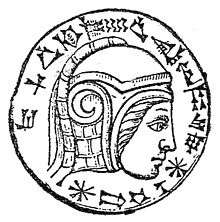Phoenicia under Babylonian rule
Part of a series on the |
||||||||
|---|---|---|---|---|---|---|---|---|
| History of Lebanon | ||||||||
 | ||||||||
| Prehistory | ||||||||
| Ancient | ||||||||
|
||||||||
| Classical | ||||||||
|
||||||||
| Medieval | ||||||||
|
||||||||
| Modern | ||||||||
|
||||||||
| Timeline | ||||||||
|
| ||||||||
Throughout her history, the lands known today as Lebanon came under foreign rule from various powers. This article deals with the time when Lebanon and much of the Levant came under the Neo-Babylonian Empire.
Background
Prior to the rise of the Babylonian Empire in the late 7th century BC, Lebanon had been a well-sought after land in the eastern Mediterranean with Hittites[1] and then Assyrians[2] occupying the country in the 13th - 12th centuries and 10th - 7th centuries respectively speaking. Following the collapse of the Assyrian Empire in Mesopotamia, Assyrian forces continued to resist their opponents evacuating into Syria, with the Neo-Babylonians under the Chaldean Nabopolassar being the most formidable enemy of them all. As the Babylonians finally defeated the Assyrians at Carchemish, much of Lebanon and Syria was already in their hands, since much of it was seized from the collapsing Assyrian kingdom.
Nabopolassar (625 - 605 BC)
Nabopolassar was the first Babylonian King to have successfully united Mesopotamia. Having married his son of to a Median princess, he turned his attention to destroying the remnants of Assyria, which had scattered into Syria. However, his attempts to defeat the Assyrians proved fruitless until his son Nebuchadnezzar crushed the Assyrians in 605 BC whilst his father lay ill in Babylon.[3]
Nebuchadnezzar (604 - 562 BC)

Nebuchadnezzar's conquest of Assyria put him at odds with the Egyptian Pharaoh, whose interests lay in keeping a friendly Assyrian state in control of parts of the Levant. Consequently, the Babylonians under Nebuchadnezzar did battle with the forces of the Pharaoh. However, the Egyptians once more proved unable to defeat the Mesopotamians and in time much of Palestine fell as well. The Economic benefits included Timber from Lebanon, which greatly financed his construction projects throughout Mesopotamia.[4]
During his rule, Jerusalem rebelled twice, resulted in two sieges. In the second siege Nebuchadnezzar's forces captured Jerusalem and inflicted a terrible sacking of the city, with the Holy Temple destroyed and thousands of Jews marched off to captivity in Babylon, as famously recorded in the Bible.[4]
Collapse of Babylon
Nebuchadnezzar's successors did him no credit and much of his gains were lost within a few decades.[4] The rise of the Persians in the East was ignored by her incompetent rulers. Even before Babylon fell, Persia conquered Syria and seized Lebanon from Babylonian rule. In the disastrous battle of Sardis, a smaller Persian army succeeded (with the aid of camels and spearmen) in defeating an alliance of Lydian princes and Asian Greeks.[5] Since Nabonidus (King of Babylon from 556 BC) had sent troops to aid against Persia, Babylon could not have expected anything less than a furious Persian army seizing her capital and her Empire.
See also
References
- ↑ Grant, R.G. (2005). Battle a Visual Journey Through 5000 Years of Combat. London: Dorling Kindersley. p. 14.
- ↑ Grant, R.G. (2005). Battle a Visual Journey Through 5000 Years of Combat. London: Dorling Kindersley. p. 17.
- ↑ Bertman, Stephen (2005). Handbook to Life in Ancient Mesopotamia. New York: Oxford UP. p. 95.
- 1 2 3 Bertman, Stephen (2005). Handbook to Life in Ancient Mesopotamia. New York: Oxford UP. p. 96.
- ↑ Grant, R.G. (2005). Battle a Visual Journey Through 5000 Years of Combat. London: Dorling Kindersley. p. 19.